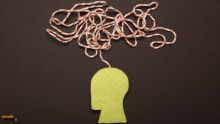Mindfulness in the distracted digital world

Digital revolution. Automation. Transformation. Industry 4.0. Data Science. Information Age. Digital Age. Each of these words trigger a thought. A feeling. A reaction.
In a rapidly changing workplace and a hyper-connected world, the concept of digital mindfulness seems like a remnant of a different age. Yet, cracking the code of becoming digitally mindful will be the key towards unlocking the true potential of workers of tomorrow.
A future-ready workforce would have to figure out a way to strike a balance in an increasingly distracted world. Otherwise, the overload of information, notifications, messages, and reminders from all the different apps coupled with the anxiety of losing one’s job to automation and new technology is more than likely to result in a burnout.
No one is immune to a burnout in this digital age! From the experienced CXO to a beginner-level new graduate who has just joined her first corporate job, everyone is facing the rising demands of an “always-on” nature of work. While wellness at work initiatives have made some strides, when it comes to promoting mental health at the workplace, there’s still a lot of work to be done.
What is mindfulness?
As the word suggests, mindfulness is being aware of your body, your emotions, your reactions, and actions--however menial and insignificant they might seem.
Many companies have found that by becoming mindful about the way employees interact with their digital environments, they can crack the code of maximizing productivity and at the same time ensuring that they have a healthy, engaged, efficient, and happy workforce.
About 85 percent of the employees surveyed by Gallup for its State of the Global Workplace report said that they were either not engaged or were actively disengaged at work. According to estimates, such a disengagement towards work results in a $7 Tn a year loss to companies.
Even when we take a look at highly engaged employees, Yale Center for Emotional Intelligence found that one out of five highly engaged employees cited that their burnout levels were high. Interestingly, the turnover rate is higher among highly engaged employees as compared to that of disengaged workers.
“The question is not IF mindfulness will come to your organization. It will come. The only question is: will you be an early adopter?” said Peter Bostelmann, Chief Mindfulness Officer, SAP, during his talk at TEDxBerlin. Having worked in the software and technology side of the business as a project management professional, Bostelmann started experimenting with meditation which helped him center himself, get ready for the projects at hand, and enhance concentration.
In this increasingly digital world, it is perfectly OK to take a step back and step away from all the devices and notifications--even if it is for a few minutes.
Under Bostelmann’s leadership, a cultural shift took place at SAP wherein employees were trained to become more mindful and present about their actions, emotions, thoughts, and mapping where their attention might be shifting its focus.
The high-pressure, deadline-oriented work environment of various sectors such as finance, technology, software firms, and even consumer goods, has given rise to the need for mindfulness at work. Thus, companies such as Google, Procter & Gamble, Nike, Zappos, etc. have recognized the vitality of mindfulness and have introduced it within their workforce. Google’s Search Inside Yourself is a program that has been recreated for their own purposes but has been heralded as a best practice for firms to implement across the globe.
Dealing with change
Most of the stress at work or in any quarter of life stems from a feeling of unpreparedness. The key lies in mentally preparing ourselves for the future. Even though the future might be full of uncertainties, it helps to train your mind to be prepared for the uncertainty.
Change is the only constant in life--is a phrase that might seem overused. However, it has never been more true than in today’s scenario.
A typically busy day for a CXO or a CHRO is packed with multiple meetings where they have to deal with a diverse group of people and important decisions are to be made. Digital mindfulness helps to center yourself before a big meeting--take a few deep breaths, focus on the present moment i.e. the meeting at hand and collect your thoughts about what needs to be done. Such simple exercises can be incorporated into the workplace within a team and as a group as well!
“Mindfulness helps you focus on the things you enjoy doing at work, and on how you can bring these tasks to the forefront,” Bostelmann said. “You then accept problems more readily because what you are working on is important to you. At the same time, you are equally able to recognize where change is needed.”
Maximizing productivity amidst distractions
An average person in the 21st century is exposed to a large amount of information within a single day--almost as much as the amount of information that a 15th century human would have encountered in their entire life. Even though “multitasking” has become a coveted skill, studies show that physically, the human brain processes one piece of information at a time. Every time the brain shifts the attention from one task to another, there is a lag time of a fraction of a second. Thus, the sounds of email notifications, vibrations from phones, and the light blinking on the smartphone from a plethora of apps contribute towards reducing the attention span, loss of focus, and stress.
“Pay attention to what is happening to you and in you when you are engaged in a digital practice,” said Dr. Richard Chambers, a Tedx Speaker, a clinical psychologist, mindfulness consultant, author, and speaker, while sharing how the digital environment impacts everyone in the workplace on an emotional and physical level. “Pay attention to the quality of your attention.”
Mindfulness in its true essence scientifically helps the body to remain calm and the mind to become open-minded. In a day and age where agility is heralded as the prime quality that sets an individual apart, mindfulness is crucial in enhancing mental agility which is the bedrock of all innovative ideas.
It not only enhances short-term memory but also empowers employees to collaborate better, resolve conflicts in an effective way, and make strategic decisions of a higher quality.
Minding your own business
While engagement in wellness initiatives from employees is a much-talked about topic, when it comes to generating awareness about mindfulness is indeed a challenge for several organizations, said Pheona Chua, Regional Senior Consultant, Corporate Health and Wellbeing, Willis Towers Watson.
"The make up of the workforce of today has a mix of employees that cuts across a spectrum of age groups--wach with different needs and desires," said Chua. "The key is to understand employees and then find practical solutions to target different groups of people."
Simple steps such as reserving 10 minutes before an important meeting for a collective mindfulness activity can ensure that employees are not only more happy but are also more attentive towards the meeting. Research shows that several digressions during a meeting can be avoided if the participants can envision the outcome that they want out of the meeting. Moreover, a focused and attentive workforce is more likely to make better-informed and holistic decisions.
"Start off by running short-term campaigns and challenges to build awareness not only among employees but also in the management," said Pheona Chua, Regional Senior Consultant, Corporate Health and Wellbeing, Willis Towers Watson. "Garner management support, encourage management leaders to share their own experiences with the employees."
Chua suggests that HR leaders and talent managers can leverage practical tools that can be applied in daily lives so that employees are motivated to adopt mindfulness as a practice.
Cracking the code of digital mindfulness in a distracted world has become even more critical in 2020. In an era where each and every one of us is involved in multiple projects and the concept of a physical office is being replaced by a very real possibility of a virtual workplace--it is no secret that the digital ecosystem is here to stay and expand in the upcoming decade. The only way to maximize human productivity is to tap into the one resource we have at our disposal (that no other technology has mastered)--the human mind.
To learn more about ways in which you can master digital mindfulness in the world of work filled with distractions, you can join many such relevant conversations at Asia’s largest HR and Work Tech Conference, People Matters TechHR 2020 Singapore from February 19th to 21st, at Marina Bay Sands.

















